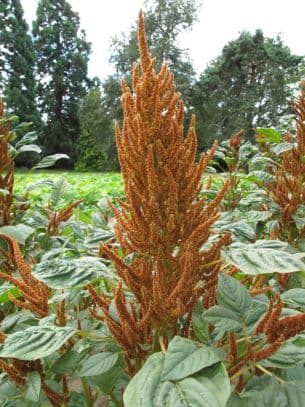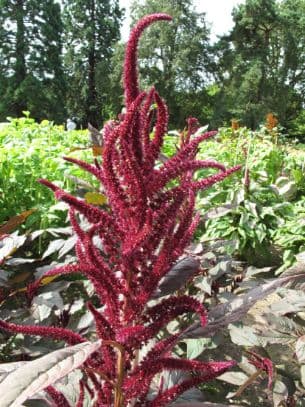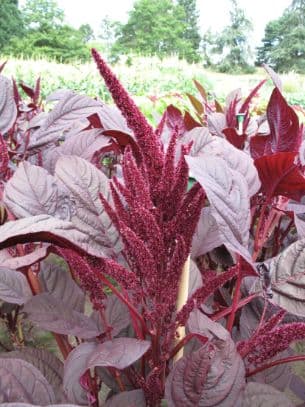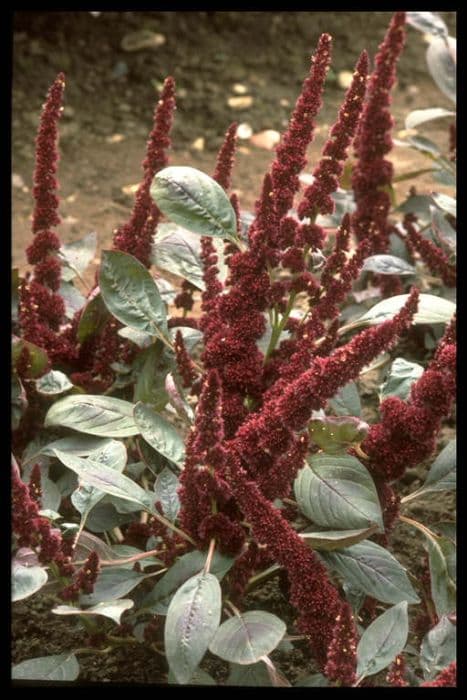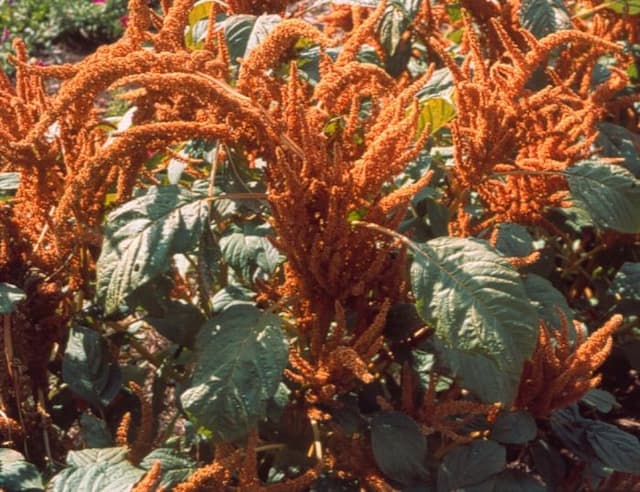Cockscomb Celosia argentea var. cristata (Plumosa Group) 'Glow Red'

ABOUT
The Celosia argentea var. cristata, commonly referred to as Cock's comb, specifically from the Plumosa Group and named 'Glow Red', is an ornamental plant known for its striking appearance. It bears vivid red flower plumes that are dense, soft, and feathery to the touch. These showy plumes have a flame-like texture, contributing to the plant's vibrant and attractive look. The leaves of 'Glow Red' are typically green, providing a lovely contrast that emphasizes the richness of the red flowers. The overall appearance of the plant offers a lush and exotic impression, making it a popular choice for gardens and displays where a splash of warm, bold color is desired.
About this plant
 Names
NamesFamily
Amaranthaceae
Synonyms
Cockscomb, Woolflower, Plume Celosia, Feathered Amaranth, Flame Flower
Common names
Celosia cristata, Celosia plumosa, Celosia argentea var. plumosa.
 Toxicity
ToxicityTo humans
Cock's comb, which is a common name for Celosia argentea var. cristata 'Glow Red', is generally considered non-toxic to humans. There are no reported symptoms of poisoning from ingestion of any parts of this plant. However, it is always advised to exercise caution and avoid ingesting plants not meant for consumption, as individual sensitivity can vary.
To pets
Cock's comb is not known to be toxic to pets. Should a pet ingest parts of this plant, symptoms of poisoning are not typically expected. As with humans, sensitivity can vary among individual animals, so it is always best to monitor your pets and keep non-food plants out of their reach.
 Characteristics
CharacteristicsLife cycle
Annuals
Foliage type
Deciduous
Color of leaves
Green
Flower color
Red
Height
1-2 feet (0.3-0.6 meters)
Spread
1 foot (0.3 meters)
Plant type
Herb
Hardiness zones
2-11
Native area
Africa
Benefits
 General Benefits
General Benefits- Ornamental value: Vibrant red feathery plumes make it an excellent choice for adding color and texture to garden beds, borders, and containers.
- Drought tolerance: Once established, it's relatively drought-tolerant, making it suitable for dry climates and water-wise gardens.
- Heat resistance: It thrives in hot temperatures, which makes it ideal for summer gardens and warm climates.
- Easy to grow: It's an undemanding plant that can thrive in a variety of soil types and requires minimal care.
- Attracts pollinators: Flowers can attract butterflies, bees, and other beneficial insects, promoting biodiversity in the garden.
- Edibility: Parts of the plant are edible, with young leaves and shoots sometimes used in dishes in its native regions.
- Fast growth: It grows quickly, providing rapid gratification for gardeners looking to establish a vibrant display.
- Long blooming period: It produces flowers for an extended period, often throughout the summer until frost.
- Seeds for next season: Produces seeds that can be collected for planting the next season, making it a cost-effective addition to the garden.
- Variety of uses: Can be used in fresh floral arrangements or dried for lasting decorations.
- Great for themed gardens: Its dramatic appearance suits specific garden designs, such as tropical or Mediterranean themes.
 Medical Properties
Medical Properties- This plant is not used for medical purposes.
 Air-purifying Qualities
Air-purifying QualitiesThis plant is not specifically known for air purifying qualities.
 Other Uses
Other Uses- Ornamental Dye: The vibrant red color of 'Glow Red' Celosia plumosa can be used to create natural dyes for textiles, offering a sustainable alternative to synthetic dyes.
- Floral Arrangements: The bright, feathery plumes of this Celosia variety add texture and a splash of color to both fresh and dried floral arrangements.
- Garden Borders: Gardeners can use 'Glow Red' Celosia plumosa to create striking garden borders that visually separate different sections of a garden.
- Photography: Due to their unique shape and vivid color, they are often used as subjects in macro photography to create stunning artwork and stock images.
- Educational Tool: Schools and educational programs can use this visually appealing plant to teach students about plant biology and cultivar development.
- Livestock Feed: In some cultures, the leaves of Celosia plants are used as supplementary feed for livestock such as chickens and goats.
- Art Supplies: The dried flowers can be used to adorn picture frames, create greeting cards, or make bookmarks as part of art and craft projects.
- Seed Harvesting: The plant is cultivated by enthusiasts who collect its seeds for trade or exchange with other flower enthusiasts.
- Culinary Garnish: Although not a common use, the striking red plumes can be used as an ornamental garnish for special dishes in gourmet cooking.
- Companion Planting: 'Glow Red' Celosia plumosa can be used in companion planting to attract beneficial insects that help control pests in the garden.
Interesting Facts
 Feng Shui
Feng ShuiThe Celosia is not used in Feng Shui practice.
 Zodiac Sign Compitability
Zodiac Sign CompitabilityThe Celosia is not used in astrology practice.
 Plant Symbolism
Plant Symbolism- Affection: The vivid appearance of 'Glow Red' Celosia, commonly known as the Cockscomb, is often associated with strong affection due to its striking resemblance to a rooster's comb.
- Intensity and Vibrance: The fiery red plumes of the Cockscomb are symbolic of intensity and vibrance, reflecting the plant's bold colors and shapes.
- Courage and Strength: Cockscomb has been associated with courage and strength, possibly due to its sturdy growth habit and the connection of roosters to bravery in many cultures.
- Innovation: With its unique crested form and textured appearance, Cockscomb represents innovation and the willingness to stand out from the crowd.
- Immutability: Because Celosia flowers can retain their color for a long time, even when cut and dried, they symbolize immutability and everlasting qualities.
 Water
WaterThe Cockscomb 'Glow Red' should be watered when the top inch of soil feels dry to the touch, usually about once a week. Use room temperature water, applying it directly to the soil until it begins to drain from the bottom of the pot, indicating thorough saturation. This might amount to approximately 16-24 ounces of water for a medium-sized pot, but the exact amount can vary depending on the size of the plant and environmental conditions. Avoid getting water on the flowers and foliage to prevent fungal diseases.
 Light
LightCockscomb 'Glow Red' thrives best in full sun conditions, with at least six hours of direct sunlight daily. The best spot for this plant would be an area that gets bright, unfiltered sunlight throughout the day, such as a south-facing window or a sunny outdoor bed.
 Temperature
TemperatureCockscomb 'Glow Red' prefers warm temperatures, ideally between 60°F and 80°F. It can handle a minimum temperature of around 40°F and a maximum of about 90°F, but for optimal growth and flowering, keep within the ideal range. Protect the plant from drafts and drastic temperature changes.
 Pruning
PruningPruning Cockscomb 'Glow Red' helps maintain its shape, encourage fuller growth, and prolong the blooming period. Snip off faded blooms and trim back any leggy stems throughout the growing season. The best time for a more extensive pruning is in late winter or early spring, just before new growth begins.
 Cleaning
CleaningAs needed
 Soil
SoilThe best soil mix for Cock's comb 'Glow Red' is well-draining, fertile soil with plenty of organic matter. An ideal mix might include peat, compost, and perlite or vermiculite for aeration. The optimal soil pH for this plant is between 6.0 and 7.0 to ensure nutrient availability.
 Repotting
RepottingCock's comb 'Glow Red' should be repotted annually, preferably in the spring. As an annual in most climates, it is typically started fresh each year from seeds or transplants rather than repotted.
 Humidity & Misting
Humidity & MistingCock's comb 'Glow Red' thrives best at moderate humidity levels. Aim to maintain humidity around 40-60% for optimal growth, as too high humidity can promote fungal diseases.
 Suitable locations
Suitable locationsIndoor
Provide bright light, warm temps, and periodical watering.
Outdoor
Full sun, well-drained soil, regular watering, and feeding.
Hardiness zone
2-11 USDA
 Life cycle
Life cycleThe life cycle of Celosia argentea var. cristata (Plumosa Group) 'Glow Red', commonly known as cockscomb, begins with seed germination, which occurs in warm, moist soil with adequate light. After sprouting, the seedlings grow rapidly and develop into young plants with distinctive foliage. Once mature, the plant produces its characteristic bright red, feather-like inflorescences throughout the warmer months, attracting pollinators and adding vibrant color to the landscape. After the flowering period, the plant sets seed, which can be collected once the flower heads dry and brown, completing the reproductive cycle. In regions with freezing temperatures, cockscombs are grown as annuals and will die with the first frost, while in milder climates they may survive as perennials or self-seed readily. The concluded growth cycle can restart if these seeds are subsequently dispersed and find suitable conditions for germination.
 Propogation
PropogationPropogation time
Spring-Early Summer
Propogation: The most popular method for propagating the Celosia, often referred to as Cockscomb, is by seed. Generally, seeds should be sown indoors 4 to 6 weeks prior to the last frost date to ensure they have enough time to mature before being transplanted outdoors. Ideally, the seeds are lightly covered with soil because they need light to germinate effectively, and are kept at a temperature of 70 to 75°F (about 21 to 24°C). The soil should be kept moist but not waterlogged. Germination usually occurs within one to two weeks. Once the seedlings have developed a couple of true leaves and have been hardened off to outdoor conditions, they can be transplanted to the garden, spaced approximately 8 to 10 inches (about 20 to 25 cm) apart to allow for proper growth and air circulation.
